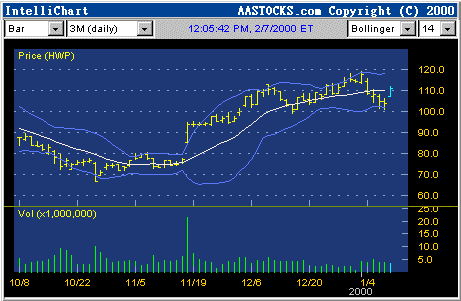|
|
|
 |
|
Technical Indicators
Over the years numerous technical indicators have
been developed to describe the stock performance, or, hopefully to predict future price
movements. In this section we introduce five of the most useful indicators, provide
examples, and explain how they are calculated.
Bollinger Band
Sometimes stock prices appear to remain in a range for extended periods of time.
A good way to describe this situation is to define a moving range around the stock
prices. Some people use an upper boundary and a lower boundary to define the range;
the upper boundary is calculated as a moving average of a chosen period plus 5% of
the price, and the lower boundary is the moving average minus 5%. These boundaries
have the drawback of being too narrow to accommodate price levels when volatility
is high and too wide when volatility is low. A better solution, recommended by John
Bollinger, defines the upper boundary as a chosen moving average plus twice the
corresponding standard deviation, with the lower boundary as the moving average minus
twice the standard deviation. The method is described below:
The Bollinger Band includes 3 lines: the upper band, lower band, and the centerline.
The centerline is simply the moving average, and the upper and lower bands are,
respectively, the center line plus/minus twice the standard deviation. For a p-period
Bollinger band:
Center Line = p-period moving average
Upper Band = Center Line + 2xStdDev
Lower Band = Center Line -2 x StdDev

Figure 5. Bollinger Band
|
